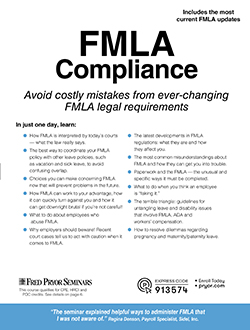Mastering FMLA: From the Basics to Real-World Challenges
FMLA Fundamentals
Key updates since the FMLA’s passage — and what they mean for employers today
Employee eligibility: Does it vary by business type or size?
How personnel policies impact FMLA benefit eligibility
Demystifying the 12-month leave calculation period
Eligibility rules for international employees
Why accurately counting your employees is critical
Do paid leave benefits need to be used before FMLA begins?
Legitimate vs. non-legitimate reasons for taking FMLA leave
How FMLA defines a “child” — and why it matters
Intermittent vs. continuous leave: Key differences and common pitfalls
The impact of “no-fault” attendance policies on FMLA compliance
Navigating Legal Overlap and Compliance
- Understanding how FMLA intersects with ADA and workers’ comp
- What employers can (and can’t) do when enforcing FMLA policies
- Required FMLA language in employee handbooks
- How to handle suspected FMLA fraud without creating liability
- Real-world legal consequences of non-compliance
- Are you obligated to provide FMLA leave if the employee doesn’t ask?
- Your duty to track and inform employees of leave usage
- Your rights when requesting medical documentation
- What to do when medical opinions conflict
- Does a paid leave request affect your rights to medical documentation?
- Avoiding legal risk when terminating employees on FMLA leave
Real-Life Scenarios & Advanced Issues
- Legally addressing potentially fraudulent FMLA claims
- Intermittent leave documentation that holds up under audit
- Protecting your company during reduced-schedule transfers
- Top Department of Labor (DOL) enforcement risks to avoid
- Upcoming DOL regulations and how they impact your obligations
- Understanding the new 26-week caregiver leave provision
- Testing “equivalent status” for reinstated positions
- When you can legally deny reinstatement
- Managing disputes over reinstatement positions professionally
- Smart communication strategies to reduce legal exposure
- Where to find the most current FMLA updates and guidance
